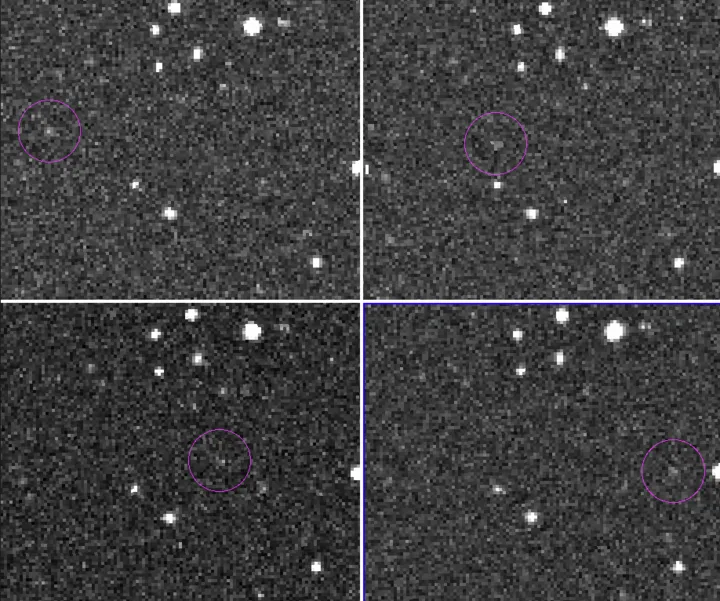An Asteroid Hit Earth’s Atmosphere Today—Here’s Why Astronomers Say That’s a Good Thing
Asteroid 2024 RW1 was discovered early this morning, marking the ninth time in history that humans have detected an approaching space rock before its impact

At around 12:40 p.m. Eastern time today, an asteroid raced through Earth’s atmosphere. You may have noticed, however, that scientific communities didn’t panic, nor did governments issue evacuation orders. That’s because the celestial object, designated asteroid 2024 RW1, posed no real danger to humans: It was only a little over three feet long, and it mostly burned up in the atmosphere over the Philippines’ Luzon Island. Any remnants of the rock probably landed in the ocean.
“An object this small can’t do any damage on the ground, we’re protected from them by the Earth’s atmosphere,” Alan Fitzsimmons, an expert in the field of asteroid and cometary science, tells New Scientist’s Matthew Sparkes and James Dinneen.
Instead, the asteroid simply created a dazzling spectacle for people in the area, streaking across the sky as a bright fireball. Despite an initial assessment from the European Space Agency (ESA) suggesting tropical storms might obscure the view of the asteroid, several videos of the space rock lighting up the night sky have popped up on social media.
Here’s how Asteroid RW1 looks like from Gonzaga, Cagayan, Philippines. Best shot so far!! pic.twitter.com/eYgQsHqxFP
— Raymon Dullana (@raymongdullana) September 4, 2024
Jacqueline Fazekas, a research technologist at the NASA-funded Catalina Sky Survey, first spotted asteroid 2024 RW1 hurtling toward Earth early this morning. The news was announced by the Catalina Sky Survey on X less than nine hours before impact.
To some, that narrow statistic might seem worrying. The detection, however, “is a good thing,” writes EarthSky’s Kelly Kizer Whitt. “We’re getting better at spotting asteroids before they hit us.”
The occurrence was “a dramatic and scientifically valuable event,” writes the International Meteor Organization’s Karl Antier. Two or three objects similar to asteroid 2024 RW1 hit our planet every year, per New Scientist, but this is only the ninth time in human history that scientists spotted one of these Earth-impacting extraterrestrial objects before it entered the atmosphere.
“The really positive aspect about this is that the survey telescopes are now good enough to spot these things coming in and give us a bit of warning,” Fitzsimmons tells New Scientist. “Put another way, if this object had been much larger and so perhaps pose[d] a threat to people on the ground, then it would be much brighter, and we’d have projected it much further out. So, this actually is a really nice demonstration that the current survey systems are doing a very good job.”
This detection is actually great news! This is only the ninth time that humankind has discovered an asteroid before it impacts Earth and is a sign of our improving planetary defence capabilities.
— ESA Operations (@esaoperations) September 4, 2024
Take a look at this graphic: https://t.co/jNz2KNE7tb
And find out more about the…
For example, one of the most notorious asteroids of the modern era, a rock called Apophis, was detected by a team of astronomers at Arizona’s Kitt Peak National Observatory in 2004. At first, researchers calculated that it had a 2.7 percent chance of crashing catastrophically into our planet, though that number has since been adjusted to zero percent for at least the next 100 years. The 1,100-foot-long asteroid is predicted to make a close pass by Earth on Friday, April 13, 2029—zooming by at a distance closer than geosynchronous satellites.
Today’s detection of asteroid 2024 RW1 is a small victory within the greater context of planetary defense. In 2022, NASA’s DART spacecraft smashed into a 525-foot-wide asteroid called Dimorphos to change its motion, demonstrating the viability of asteroid redirection. Basically, if a threatening object is found hurtling toward Earth, DART suggests we have a chance of diverting its path by crashing a spacecraft into it.
In October, the European Space Agency’s Hera spacecraft is scheduled to launch on a mission to carry out a post-impact survey of Dimorphos, in hopes of turning NASA’s DART experiment into a repeatable technique.
WELCOME TO EARTH, ASTEROID 2024 RW1!
— ScienceKonek (@sciencekonek) September 4, 2024
Here's a clear shot of the much-awaited small asteroid 2024 RW1 (#CAQTDL2) burning bright into a greenish 'fireball' over Lal-lo, Cagayan around 12:39 AM PhST, 05 September 2024. Did you see it too?
… pic.twitter.com/B3oAm6nNdD
The advance detection of the asteroid that impacted Earth today is “a sign of our improving planetary defense capabilities,” ESA Operations writes on X.
Hopefully, that means that if a much larger object than asteroid 2024 RW1 gets too close for comfort in the future, we’ll be ready.

